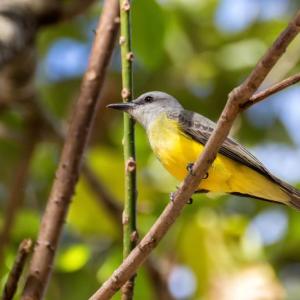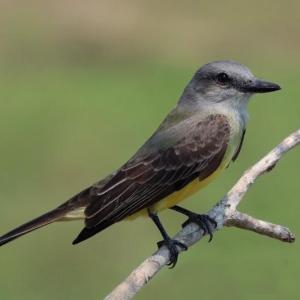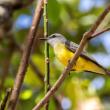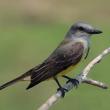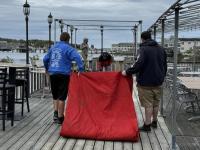A Tropical Visitor Enjoys a Maine Summer
 Tropical kingbirds are rare to Maine, though one is currently enjoying the summer here. The one shown here, photographed in Venezuela, shows off the rich yellow undersides that are in contrast to the white undersides of our common, expected eastern kingbird here in Maine. Photo by Fernando Flores from Caracas, Venezuela, CC BY-SA 2.0 , via Wikimedia Commons
Tropical kingbirds are rare to Maine, though one is currently enjoying the summer here. The one shown here, photographed in Venezuela, shows off the rich yellow undersides that are in contrast to the white undersides of our common, expected eastern kingbird here in Maine. Photo by Fernando Flores from Caracas, Venezuela, CC BY-SA 2.0 , via Wikimedia Commons
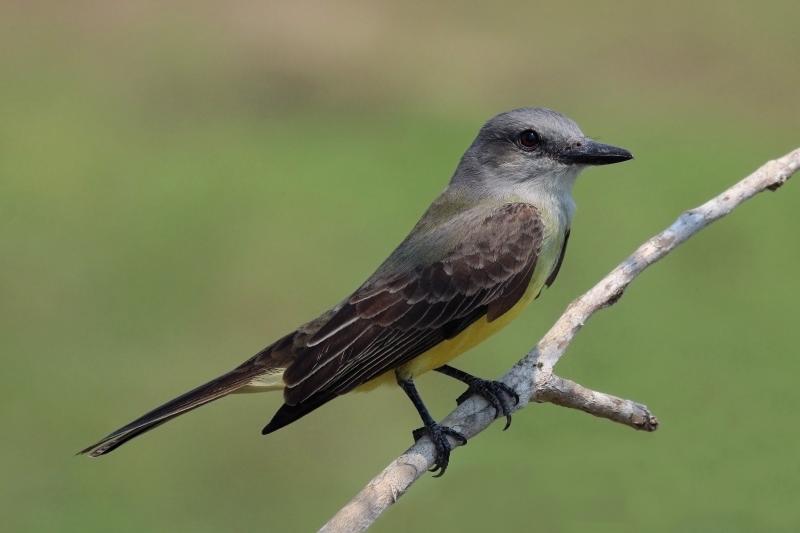 Tropical kingbirds occur from southeast Arizona and southern Texas south through Mexico, Central America and South America to Argentina. Photo by Charles J. Sharp, CC BY-SA 4.0 , via Wikimedia Commons
Tropical kingbirds occur from southeast Arizona and southern Texas south through Mexico, Central America and South America to Argentina. Photo by Charles J. Sharp, CC BY-SA 4.0 , via Wikimedia Commons
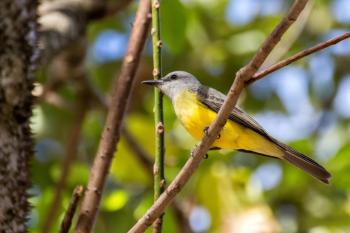 Tropical kingbirds are rare to Maine, though one is currently enjoying the summer here. The one shown here, photographed in Venezuela, shows off the rich yellow undersides that are in contrast to the white undersides of our common, expected eastern kingbird here in Maine. Photo by Fernando Flores from Caracas, Venezuela, CC BY-SA 2.0 , via Wikimedia Commons
Tropical kingbirds are rare to Maine, though one is currently enjoying the summer here. The one shown here, photographed in Venezuela, shows off the rich yellow undersides that are in contrast to the white undersides of our common, expected eastern kingbird here in Maine. Photo by Fernando Flores from Caracas, Venezuela, CC BY-SA 2.0 , via Wikimedia Commons
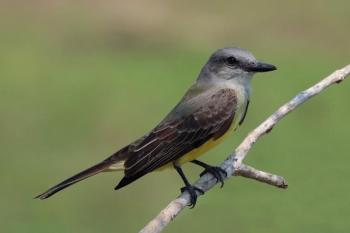 Tropical kingbirds occur from southeast Arizona and southern Texas south through Mexico, Central America and South America to Argentina. Photo by Charles J. Sharp, CC BY-SA 4.0 , via Wikimedia Commons
Tropical kingbirds occur from southeast Arizona and southern Texas south through Mexico, Central America and South America to Argentina. Photo by Charles J. Sharp, CC BY-SA 4.0 , via Wikimedia Commons
We might be far from the tropics, but the temperature sure has felt downright tropical here in Maine (and across much of the nation) over the last few weeks. Maine and much of the country also got a few rain showers a few weeks ago, complete with flood warnings—dubious presents from the tropics in the form of the remnants of Hurricane Beryl.
So maybe it shouldn’t come as a complete surprise that Maine received a visit from a decidedly tropical bird visitor as well—a species known as the tropical kingbird.
The bird has apparently been in residence for some time, perhaps since June but certainly since earlier in July, near the Skelton Dam along the Saco River in Dayton, just west of Saco. The broader birding community didn’t catch wind of it until the last week or so, but since then lots of people have had a chance to see this yellow-bellied beauty as it flutters out for bugs from the utility wires.
In case you are wondering, tropical kingbirds are not normally found in Maine. When we say “not normally,” we really mean it. The species has been documented here in the state only twice before: once in Scarborough in October 1915 and then again more than a hundred years later in October 2019.
Tropical kingbirds are a widespread and common bird across much of the Americas from Mexico south through Central and South America to Argentina. Interestingly, they are not found in the Caribbean, except in small numbers some years on the islands of Aruba, Curaçao and Bonaire, just off the coast of Venezuela.
The species does make it regularly into the U.S. – just barely. Tropical kingbirds have nested in Southeast Arizona since at least 1938 and expanded into the Rio Grande Valley of Texas in the 1990s. But Maine is not Texas!
Why, you may ask, would a tropical kingbird come to Dayton, Maine, in the summer of 2024? It’s a great question, and exactly the kind of question that bird enthusiasts and ornithologists love to ponder. One clue to the mystery of the tropical kingbird appearance in Maine may have to do with that very widespread range across the Americas that we mentioned earlier. We tend to forget that in the Southern Hemisphere, in places like Argentina, they experience a cooler winter season during our summer. Birds like tropical kingbirds nest in Argentina during our winter and migrate north during the Southern Hemisphere fall (April-June) to northern South America.
Close examination of the Dayton tropical kingbird showed that it was an adult with characteristics consistent with the subspecies found in southern South America. Putting the clues together, one likely scenario for the bird’s journey to Maine is that this particular bird came north, perhaps from Argentina, in the austral fall, which overlaps in time with the northern spring. For some reason, this particular individual just kept going past its northern South America wintering grounds and crossed northward into a second summer in the northern hemisphere.
Will it find its way south again during our fall and keep going across the equator to join in the austral spring migration all the way back to Argentina again?
There is so much we still don’t know about birds. Isn’t it wonderful!
Jeffrey V. Wells, Ph.D., is a Fellow of the Cornell Lab of Ornithology and Vice President of Boreal Conservation for National Audubon. Dr. Wells is one of the nation's leading bird experts and conservation biologists. He is a coauthor of the seminal “Birds of Maine” book and author of the “Birder’s Conservation Handbook.” His grandfather, the late John Chase, was a columnist for the Boothbay Register for many years. Allison Childs Wells, formerly of the Cornell Lab of Ornithology, is a senior director at the Natural Resources Council of Maine, a nonprofit membership organization working statewide to protect the nature of Maine. Both are widely published natural history writers and are the authors of the popular books, “Maine’s Favorite Birds” (Tilbury House) and “Birds of Aruba, Bonaire, and Curaçao: A Site and Field Guide,” (Cornell University Press).

